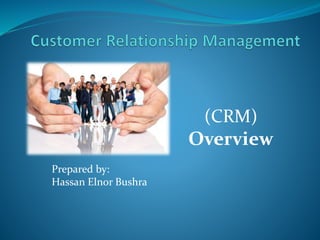
Customer relationship management
- 1. (CRM) Overview Prepared by: Hassan Elnor Bushra
- 2. (CRM) Definition: Customer Relationship Management (CRM) is a strategy for managing a company’s relations and interactions with customers, clients and sales prospects. It involves using technology to organize, manage, automate, and synchronize business processes. For example, an enterprise might build a database about its customers that described relationships in sufficient detail so that the company, salespeople, people providing service, directly could access information, match customer needs with product plans and offerings, remind customers of service requirements.
- 3. CRM Marketing Customer services PRM Identify & Target potential clients. Generate leads for the sales team. Tracking & Measuring multichannel campaign. Develop the client relationship. Increase efficiency. Minimize costs. Attracting & retaining customers.
- 4. (PRM) Prospect Relationship Management (PRM) . This marketing concept was founded in the 2000s, refers to the methods and tools (software) for managing leads, is to tell potential customers approached by the company. The Prospect Relationship Management (PRM) is complementary to the customer relationship management (CRM). The Prospect Relationship Management (PRM) assumes that the relationship with prospects must be considered to maximize the opportunities for conversion, using various techniques, including data mining, software monitoring, contact centers, etc..
- 5. Customer Relationship Management includes: CRM processes that help identify and target their best customers, generate quality sales leads, and plan and implement marketing campaigns with clear goals and objectives. CRM processes that help form individualized relationships with customers (to improve customer satisfaction) and provide the highest level of customer service to the most profitable customers. CRM processes that provide employees with the information they need to know their customers' wants and needs, and build relationships between the company and its customers.
- 6. Phases The three phases in which CRM support the relationship between a business and its customers are to: 1. Acquire: CRM can help a business acquire new customers through contact management, selling, and fulfillment. 2. Enhance: web-enabled CRM combined with customer service tools offers customers service from a team of sales and service specialists, which offers customers the convenience of one-stop shopping. 3. Retain: CRM software and databases enable a company to identify and reward its loyal customers and further develop its targeted marketing and relationship marketing.
- 7. (CRM) Tools Customer relationship management tools include software and browser-based applications that collect and organize information about customers. For instance, as part of its CRM strategy, a company might use a database of customer information to help construct a customer satisfaction survey, or decide what the product that needs to develop or which new product their customers might be interested in.
- 9. Benefits of CRM The use of a CRM systems will confer several advantages to a business: Quality and efficiency. Decreasing costs. Decision making support. Enterprise agility. Develop the product. Develop the clients relationship. Develop targeted marketing. Generate leads for the sales team.
- 10. Examples of CRM software: CRM-Express Professional. Dynamics CRM. Civi CRM. Base CRM. Pivotal CRM. Epesi CRM.
